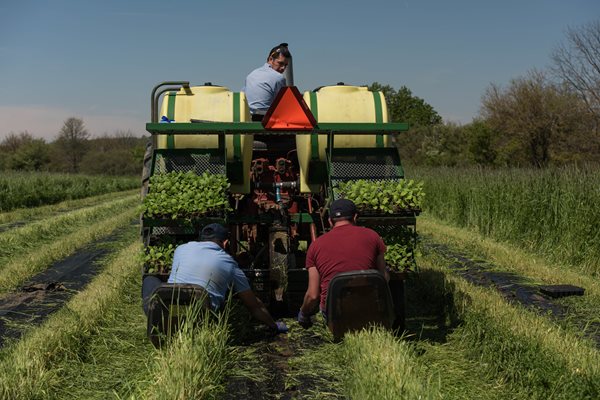If you’ve saved a corsage from a long-age dance and have fond memories of that event, you’ll understand why we love squash blossoms so much. This is the gorgeous bloom at the center of our first dance with a chef—and what makes it especially meaningful is that it’s a waltz that we continue to enjoy each year in uniquely wonderful ways.
Here’s another reason why we adore squash blossoms. They perfectly represent our focus on appreciating every edible part of a plant and dovetail beautifully with our passion and commitment to avoiding food waste.
In short, we cherish squash blossoms, and if Farmer Lee Jones ever wakes up at dawn one morning with a hankering to wear a boutonniere, we all know what bloom will be spotlighted: the absolutely incredible, one-of-a-kind, second-to-none squash blossom.
Story of the Squash Blossom
About 35 years ago, after we’d lost our farm through a combination of high interest rates and a devastating hailstorm, Farmer Lee was at a farmer’s market by Cleveland where a classically trained chef, Iris Bailin, had returned home from Europe. She was seeking ingredients that were easy to find there—but she couldn’t find them in the United States. Iris then asked Lee if he would sell her the squash blossoms that grew on their squash.
Lee was puzzled because they would throw those blossoms away. When he told his dad about the request, Bob Sr. just laughed because NOBODY ate those. Right?
Lee told Iris what his father said—but he also snuck her a few squash blossoms.
Here is what he recalls about that moment: “She started making such a ruckus about the flavor and quality of the blossoms that other farmers at the market started to head towards our truck to see where all the noise was coming from. Upset that I had only brought a few flowers with me, she still offered to buy what I had, and for 50 cents apiece! Now, it was my turn to be floored. This was a new territory for us. A chef was going to buy these flowers from us at a great price and then cook with them? And she wanted more? I couldn’t wait to share the news with my family, and honestly, I couldn’t wait to see what other things Iris might ask us for.”
Bob Sr. ultimately made the decision that changed the trajectory of the farm for good: to grow specialty items for chefs, ones they couldn’t find elsewhere.
Super Sexy Summer Squash
At The Chef’s Garden, we grow summer squash in various sizes, nurturing each plant with plenty of personalized attention and care. Take a look!
You can choose our mixed summer squash in baby, petite, and young sizes—and you’ll receive the best of the day’s harvest in a mix of rich yellows and deep greens that offer sweet and nutty flavors. Or you can select the squash with bloom, where an eye-catching summer squash—deliciously tender inside with firm skin—is topped off by a stunning bloom that’s both soft and slightly flowery. Or, if you plan to stuff squash blossoms or otherwise use them in your creative dishes and menus, you can order the blossoms. Whatever you need, we have!
Squash Recipes
Here are just some of the ways that we adore squash and their blooms:
- Summer Squash Tart Recipe
- Baked Ricotta Squash Blossom With Squash Attached
- Seared Summer Squash
- Squash Blossom Quesadilla
- Squash Blossom Tomato Herb Focaccia
- Summer Succotash with Squash Blooms
Use these as starting points for your own creative dishes and menus!
History of Summer Squash
According to the United States Department of Agriculture (USDA) and the Wisconsin Department of Public Instruction, the earliest squash was found in Mexico—10,000-year-old summer squash seeds were found in caves there—and in other parts of Central America (12,000-year-old seeds have been recovered in Ecuadoran caves). A few hundred years ago, Christopher Columbus and other explorers took squash back to their native countries, thus spreading where people could grow, eat, and enjoy this luscious veggie.
Summer squash is delectable when cooked—and flavorful when raw. So, it’s unsurprising that a Native American name for it was “askutasquash,” which translates into “eaten raw.” It’s also easy to see how this term could be shortened into today’s “squash.”
Now, remember how—at The Chef’s Garden and the Culinary Vegetable Institute—we focus on using every edible part of a plant, experimenting with unique ways to fully enjoy less traditional parts? According to the Library of Congress, early on, squash may have been hollowed out, with the outer portions used as “containers or utensils.” Only later was it likely that South and North American natives recognized the delicious and nutritious value of its flesh.
Nutritional Value and Health Benefits of Squash
According to Healthline.com, yellow squash is a “serious nutritional power-packed veggie,” containing “vitamins A, B6, and C, folate, magnesium, fiber, riboflavin, phosphorus, and potassium” and being “rich in manganese.”
WebMD.com lists key health benefits of squash, including cancer prevention, slowing down the progression of macular degeneration, helping to prevent the development of cataracts, reduced risk of depression, and enhanced skin protection.
Summer squash is also listed in The World’s Healthiest Foods. When making their list, the editors examine 29 different nutrients and rank a particular vegetable on each one. Next, they total the number of ratings of good, very good, and excellent that veggie has—and summer squash comes in with 20, which is a great score.
Enhanced Nutrition through Regenerative Farming
We grow our summer squash—and other crops—through regenerative farming techniques that maximize nutrition. Independent lab studies show that the minerals in our veggies significantly outpace USDA baselines.
We minimize any tillage and optimize and balance the physical, biological, and chemical health of our soil through the strategic use of biodiverse cover crops. We treat our soil like a cherished crop, farming in harmony with Mother Nature in ways our grandparents and great-grandparents would recognize.
Healthy soil. Healthy crops. Healthy people. Healthy planet.
You probably hear a lot about people’s immune systems nowadays, especially after the tumultuous year we all experienced in 2020. Well, plants have their own immune systems, too, and they develop strong ones when planted in healthy soil. This makes them less susceptible to disease, just like a healthy immune system can do for people.

As Bob Jr. explains the process of caring for soil to grow healthy crops, “Soil is a living, breathing organism just like we are, and you have to treat it as such. It needs food, air, and water to be productive. And, if you really want it to be productive, you’ve got to give it rest—the same things we need.”
He adds the following: “This process allows us far less competition from weeds. And, even more important for chefs, this allows us to eliminate the need for chemicals. Sure, we could do one quick till and then pour chemicals onto the land, but we’re never about minimum standards. We want to produce healthy, nutrient-dense products for chefs without harming the land for future use.”
Thoughts from Farmer Lee Jones: Then and Now
When Lee was in elementary school (wasn’t he exceptionally stylish, even then?), he dreaded when it was time to pick squash. He needed to wear long sleeves and gloves to avoid the tiny little prickers on the veggie. If he decided to skip wearing them, he could count on red and irritated skin from his wrists to his elbows.

Waiting until tomorrow wasn’t a great strategy, either, because squash grows like crazy in hot weather. This meant squash needed to be picked daily to prevent them from getting too big and taking up too much of the sun’s energy.
Fast-forward to today and Farmer Lee greatly appreciates the incredible dishes that chefs create with fresh squash from The Chef’s Garden—and from the squash blossoms, too.
Order Your Summer Squash and Squash Blossoms
Contact your product specialist today to get the farm-fresh summer squash and squash blossoms you need for incredibly delicious dishes and menus.
Thank you for allowing us to be your personal farmer!

